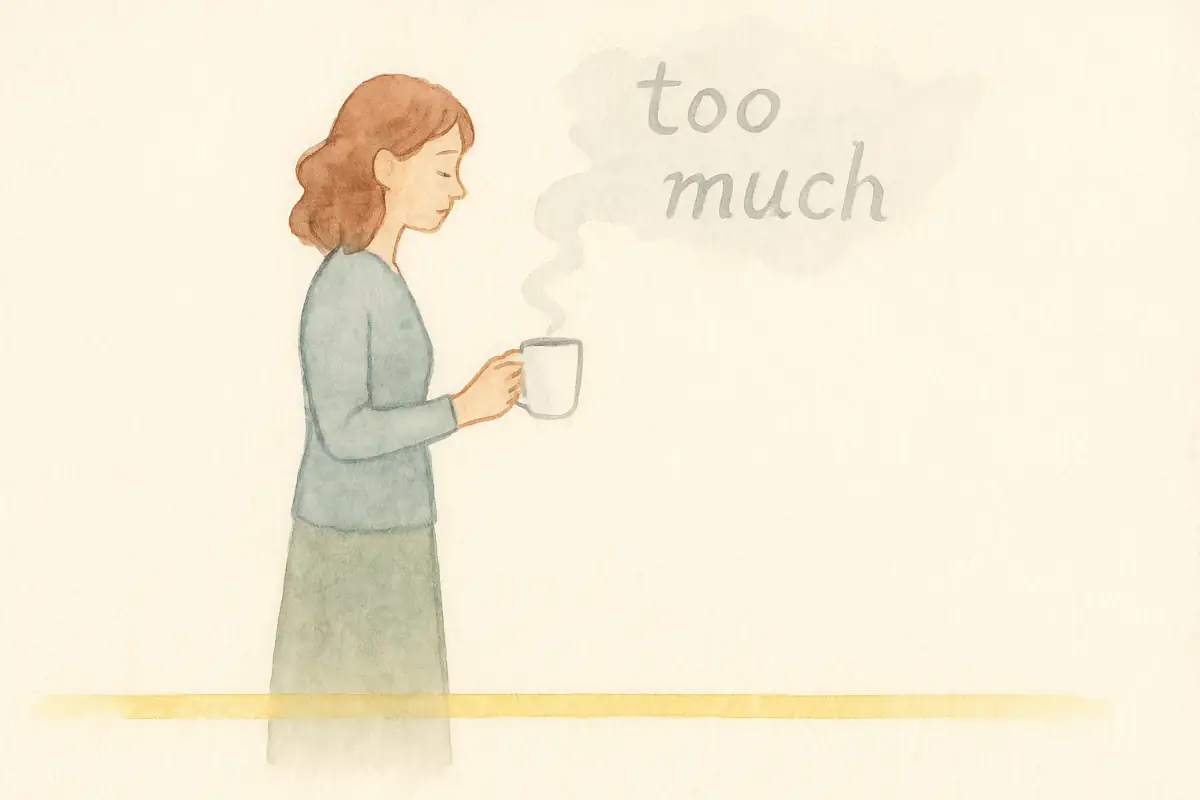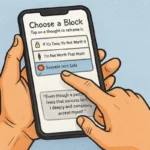The Fear of Being “Too Much”: A Tale of Two Trains
(With guidance from Imi Lo)
Prologue — Platform of Smallness
The station smells faintly of wet stone and fresh bread from the bakery across the street. The coffee in her hands fogs the edges of her glasses. She stands just shy of the yellow line, heart ticking faster than the clock overhead, although nothing is “wrong.” Not exactly.
She’s lived most of her life here—
not on this platform,
but in this state.
Waiting. Watching. Measuring her volume, her expressions, her very presence, trimming away anything that might seem like “too much.”
It started early—loud laughter met with sharp glances, tears labeled “overreactions.” Over years, she learned the art of shrinking until she could slip through life unnoticed.
This morning, the old ache stirs. The story whispers:
Don’t take up space. Stay small. Stay safe.
The train sighs into the station. Doors open. She steps forward—
—and here the story splits.
Reality One — No Anchors
She boards without a thought, slides into a corner seat, knees together, coffee balanced precisely on her lap.
A man across the aisle glances up. She drops her gaze, heat rushing her cheeks. Fingers fuss with the cup lid.
Her phone buzzes—coworkers discussing the morning meeting. She knows she has an idea that would help the project, but her throat is already tight. She sends an emoji instead.
Reality Two — Invisible Anchors
She feels the familiar pull to rush aboard and disappear. But her right thumb presses into the fleshy side of her left hand—
Karate Chop (KC) Point—while her index finger braces the opposite edge.
Seven seconds. Inhale through the nose, slow exhale through parted lips. Three times.
When she steps on, her spine is straighter. She meets the glance of the man across the aisle and holds it for a heartbeat before looking away. Not hiding. Just present.
Scene Two — The Meeting
No Anchors
She slips in late, hoping no one notices. At the back, she keeps her eyes on her notepad.
The team hits a problem she’s thought about all weekend. Her heart races. She rehearses her idea in her head, but before she can speak, the discussion shifts. Someone else offers a similar thought—earns nods and praise. Her stomach drops.
Invisible Anchors
Beneath the conference table, her thumb presses into the KC Point, index finger braced on the opposite side. Seven seconds of pressure, timed to her breath.
And she keeps it as she says:
“The data suggests we’re overlooking the onboarding friction.”
As she elaborates, her index and middle fingers hook into the Collarbone Point—just below the hard notch—disguised as adjusting her lanyard. The numbers in her mind stay crisp.
Scene Three — The Train at Noon
No Anchors
A child’s scream ricochets through the crowded car. She grips her bag tighter. Jaw locked. Shoulders inching upward until her neck aches.
Invisible Anchors
The same scream cuts through the air. She tucks a stray hair behind her ear—index and middle fingertips settling on the Top of Head (Crown) Point. Ten slow seconds, counting:
Inhale (1-2-3-4) … Hold (1-2) … Exhale (1-2-3-4-5-6).
The sound still grates, but her shoulders stay loose against the seat.
Scene Four — Lunch
No Anchors
“You’ve been quiet today,” a coworker says. She shrugs, eyes on her salad. “Just tired,” she murmurs.
Invisible Anchors
Same comment. She finds the webbing between her pinky and ring finger—the Gamut Point—and applies steady pressure. Three cycles of box breathing (inhale-4, hold-7, exhale-8).
“Just thinking through the Patterson account,” she says. Not a lie. Not the whole truth. But enough—and her chest feels less tight.
Scene Five — Afternoon Ripple
No Anchors
She types emails. Avoids the break room. Watches the clock drag toward five.
Invisible Anchors
As office chatter swells and focus scatters, she presses the Collarbone Point again—this time disguised as straightening her shirt collar. Her breath slows. She finishes her report fifteen minutes early.
Scene Six — The Ride Home
No Anchors
She stands in the train’s corner, eyes on the floor, earphones in without music. A dull loneliness blooms in her chest.
Invisible Anchors
Crowded train, no seats. A man beside her shifts irritably. She digs a knuckle from her left hand into the fleshy padding of her right—KC Point again—then squeezes the Finger Points in sequence: thumb, index, middle, ring, pinky.
Each squeeze lands on the side of the finger near the nail base, just where the skin meets the nail plate. With each, she exhales silently. By her stop, her mind feels steady, her body grounded.
Evening Convergence
No Anchors
The apartment is dim. She drops her bag, changes clothes, sinks into the couch. Scrolls. Missed chances flicker at the edge of her mind, but she pushes them aside. The heaviness remains.
Invisible Anchors
She sets her bag down, slips into soft clothes, makes tea. Before the kettle clicks, she sits at the table.
The day replays—each point pressed, each breath counted, each choice to stay present. She feels grateful… and still a little taut.
She decides to “close the loop” with a complete EFT session.
Full Evening EFT Session
Setup (KC Point) – tapping the fleshy side of the hand:
“Even though I still feel the edges of today’s stress, I honor how I showed up for myself.”
Eyebrow Point – “The tightness I felt this morning.”
Side of Eye – “The sound on the train that grated my nerves.”
Under Eye – “The moment I almost stayed silent in the meeting.”
Under Nose – “It’s okay that I still feel some of that tension now.”
Chin Point – “I’m learning to take up space, one breath at a time.”
Collarbone Point – “It’s safe to be here.”
Under Arm – “I don’t have to get it perfect.”
Top of Head (Crown Point) – “I’m allowed to shine.”
Finger Points – Squeezing each fingertip in sequence, starting with the thumb.
Gamut Point – Gentle pressure, anchoring the round.
Three full rounds. She finishes with both hands over her heart. The tension hasn’t vanished, but it has softened—like ice melting in warm water.
She sips her tea and thinks,
Today I didn’t just ride the train. I took the wheel.
Epilogue — The Art of Unseen Anchors
You don’t always have the privacy for a full EFT sequence. But you can still use standard EFT points in subtle, public-friendly ways—your own Invisible Anchors—to regulate your nervous system in real time.
These aren’t replacements for full EFT processing. Think of them as nervous system first aid—simple, silent adaptations that help you stay grounded until you can do deeper work.
Karate Chop (KC) Point – Hand Edge
Standard EFT location: Side of the hand between pinky base and wrist.
When: Pre-presentation, tough questions.
Invisible Anchor: Thumb presses into hand edge for 7+ seconds.
Disguise: Resting chin on hand, gripping a phone.
Collarbone Point
Standard EFT location: Just below the collarbone notch, slightly to the side of the breastbone.
When: Crowds, sensory overload.
Invisible Anchor: Press index/middle fingers while “adjusting a necklace.”
Why: Light pressure here stimulates the vagus nerve (Porges, 2017).
Top of Head (Crown) Point
Standard EFT location: Directly on the crown of the head, in line with the ears.
When: Emotional flooding, intrusive thoughts.
Invisible Anchor: Index and middle fingertips press lightly for 10+ seconds, paired with extended exhales.
Disguise: Hair tucking, hat adjustment.
Gamut Point
Standard EFT location: Back of the hand, between the knuckles of the pinky and ring fingers.
When: Conversation anxiety, rumination.
Invisible Anchor: Apply gentle pressure with the opposite thumb.
Why: Part of the “9 Gamut” procedure, helps shift mental focus.
Finger Points
Standard EFT location: On the side of each finger near the base of the nail, where the fleshy skin meets the nail plate—imagine where you’d clip a hangnail, just beside the nail at the cuticle line.
When: To complete a sequence or subtly calm during conversation, travel, or meetings.
Invisible Anchor: Squeeze or tap each fingertip in sequence against the opposite thumb.
Disguise: Rubbing fingertips together, “cracking” knuckles, rolling a pen.
Quick Calm ≠ Full Processing
- Works best when paired with intentional breathing.
- Practice even when calm so it becomes automatic.
- Use without self-judgment if the mind stays busy.
The goal isn’t to erase discomfort—it’s to stay grounded inside it, long enough to choose expansion over contraction.
Your anchors are always with you:
A thumb against your hand.
A fingertip on your crown.
The steady rhythm of your own breath.



